In this article, we review the Topping E70V balanced desktop DAC featuring AKM’s latest AK4499EX flagship DAC chip. It costs $449 USD.
Disclaimer: ShenzhenAudio sent us the Topping E70V for the purpose of this review. As always, I am here to convey my honest experience with the product.
Topping
Topping Electronics & Technology, known as ‘TOPPING’, is based in Guangzhou, China, and was established in 2008. They design some of the best DACs and AMPs when it comes to the price-to-performance ratio. They have a dedicated R&D team of skilled engineers and audiophiles. In addition to that, they are heavily invested in the latest audio testing machinery such as the APx555 from Audio Precision. Of course, all of this means one thing for us consumers, better devices!
I have used numerous Topping products in the past, the oldest two I remember are the TP30 and the NX1. The year was 2013 I believe. I never had any problems with their products despite using 30+ of them throughout the years. They have a really good track record and they strive to do better.
Today we are reviewing the E70V. It is the AKM version of the critically acclaimed E70 DAC. Topping’s line-up is growing each passing day with fantastic devices. If you want to check out more Topping gear, you can find all of our related reviews here.
Topping E70 VELVET Balanced DAC with LDAC
The ‘V’ in the name of the Topping E70V is a reference to the VELVETSOUND technology of AKM DACs. You can read more about the technology, here. Most of you are already familiar with this technology, reminding you that it has been around for quite a long time, and Astell&Kern pioneered its marketing in portable devices. The E70V is named with the letter ‘V’ in its name, referring to the VELVET SOUND technology of AKM dacs. Most of you are already familiar with this technology, reminding you that it has been around for quite a long time, and Astell&Kern pioneered its marketing in portable devices.
For me, the important thing here is not the V in the name, but the revised flagship DAC chip called 4499EX at the heart of the DAC’s board, which AKM released after the disaster. This chip is AKM’s best chip available at the moment and combined with Topping’s prowess in DAC development and implementation, the result is a very competitive product, priced at $449 USD. (Limited time price: USD 389 from ShenzhenAudio). Apart from the DAC, the E70V is no different from the E70, so the first page of the review, which includes specifications and features, will be followed by excerpts from the E70 review. On the second page, we will talk about the characteristic differences between the E70 and the E70V.
With the exception of the DAC chip, the physical differences between the audio boards of the two machines are quite minimal. Despite Topping’s brand-new low-noise PSU design, the E70V’s noise level is the same as the E70’s (<1.3uVrms). Which is outstanding. The E70 is an impressive DAC, and the Velvet version has a slightly different signature, which we’ll explore on page 2.
The E70 and E70V also incorporate the latest technologies and improvements developed by Topping. Let’s take a look at the details. First of all, we see the first use of the new USB controller from XMOS. Called XU316, this 32-bit multicore controller replaces the long-running XU216. The plug-and-play feature, which allows the product to work seamlessly with all kinds of devices, has been further improved and offers maximum compatibility and stability with all devices except applications that require Windows-ASIO.
The E70 & the E70V have the LDAC support we’ve been waiting for and come with Qualcomm’s QCC5125, a premium-tier chipset. It supports popular codecs such as LDAC, AptX HD, and AptX LL.
Here are the highlights:
- AKM AK4499EX Flagship DAC
- XMOS XU316 3rd gen USB Controller
- Qualcomm QCC5125 Bluetooth 5.1 Chipset with LDAC
- Remote Control Support
- USB-B / Coax / Optical / RCA / XLR
- XLR 4V/5V & RCA 2V/2.5V
- 32bit-768kHz PCM & DSD512 Support
- 12V Trigger (3.5mm)
- The latest DAC drivers can be found here. E70V’s webpage is here.
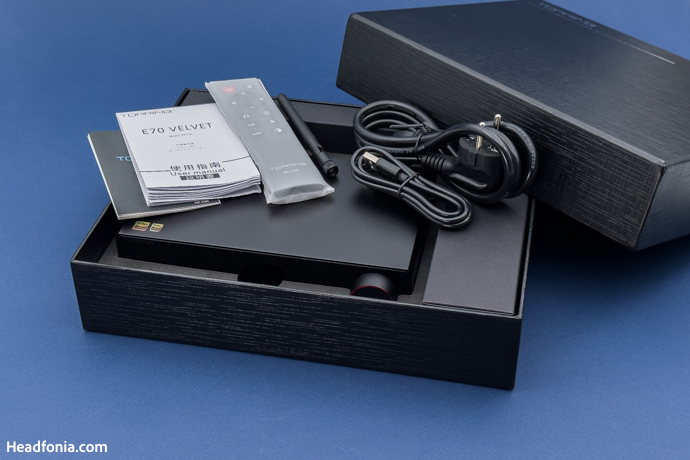
Packaging & Accessories
Topping has completely revamped the unboxing experience. The E70V’s box is completely black. It has a textured finish with a crosshatch pattern, giving it a premium vibe. There are no product details or specifications anywhere on the box. The Topping brand name is on the front in silver letters and looks quite elegant. On the side of the box, there is the company’s address and a QR code, also in silver letters. Scanning this QR code takes you to the company’s website.
When you open the hardened cardboard box, you are no longer greeted by a compartment made entirely of foam. Instead, we see a more elegantly compartmentalized box layout, a mix of cardboard and dense foam. On the right is a large cardboard box containing the device’s IEC 13 power cable. At the top side, there is a smaller box containing the rest of the accessories that come with the device. The E70V comes with a remote controller, a BT antenna, and a USB-A to USB-B cable along with a couple of manuals.
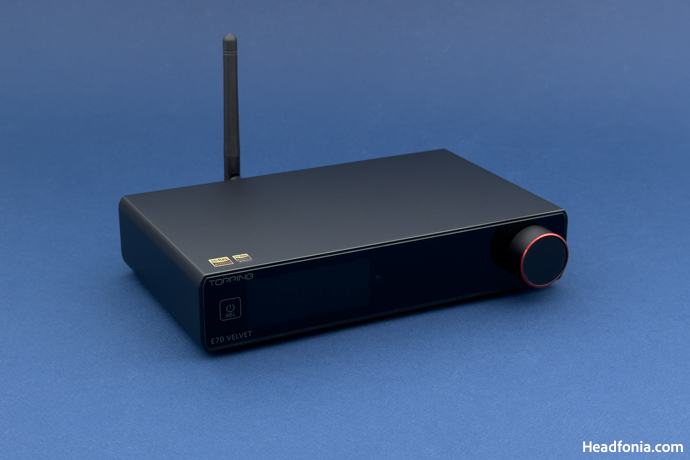
Design & Build Quality
Measuring 20 x 13.8 x 4.4 centimeters (WxDxH), the E70V DAC is not the most compact stack Topping has ever made, but it is smaller than its competitors, assuming it delivers high-end performance. The design of the E70V is similar to what we have already seen on the E30 II and E50, but the E70V has a wider form than those two devices. The DAC has a CNC-machined aluminum alloy chassis with a black glossy panel on the front.
All inputs and outputs are located on the back. Topping has used its usual anodized metallic paint on the E70V and like almost all other Topping devices, the device looks very elegant up close. The reason why we praise this paint so much is that it has a nice flaky shine under light and more importantly, provides excellent scratch resistance. Side note here, should any of our readers wish to carry it, the device weighs around 700 grams.
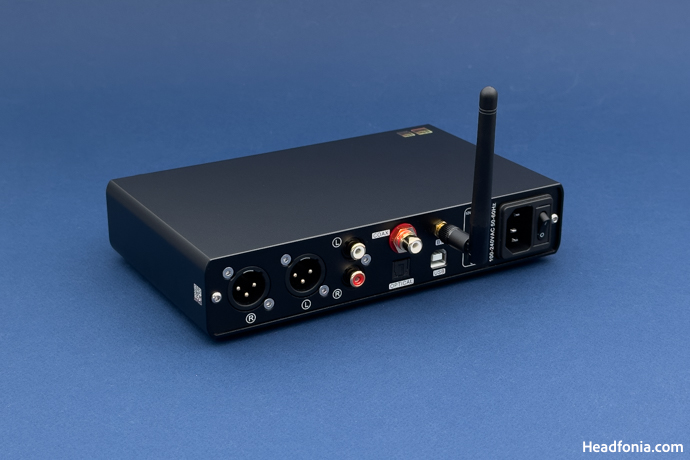
On the left side of the glossy front panel, right next to the power button, there is a white LED display. At first glance, the brightness of the screen is much brighter than Topping’s previous devices. The layout of the device is quite simple. Topping has placed a volume knob on the front and you can adjust the volume of the device in preamp mode via this knob. This knob can also be used for navigation, albeit limited. We’ll talk more about this in the controls & UI section.
Going back to the layout, we mentioned that there is a power button on the front of the device. A long press of this power button puts the device on standby and a short press changes the active input. All inputs and outputs of the device are located on the back. The device has unbalanced RCA and balanced XLR as outputs. The device features USB-B, optical, and coaxial options as inputs.
The quality of the sockets used is great, as expected from Topping. The sockets seem rigid and durable with no wobble. I do not see any chassis imperfections that could’ve occurred during CNC and there are no assembly issues either. Topping has been quite consistent in this regard for a long time. As for the design; Topping could have offered the E70 and the V with the oval design they introduced with the DX5, but that would probably have had a negative impact on the price. Maybe next time Topping will surprise us and give us a design update without bumping up the price, who knows?
The review continues on Page Two, after the click HERE or by using the jump below.
Page 1: Topping, Topping E70V Desktop DAC, Packaging & Accessories, Design & Build Quality
Page 2: DAC Performance Controls & UI, DAC Performance, Bluetooth Performance, Comparison, Last Words







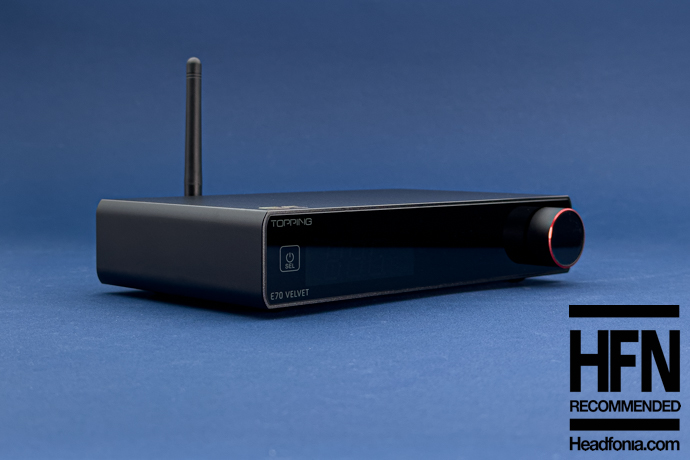
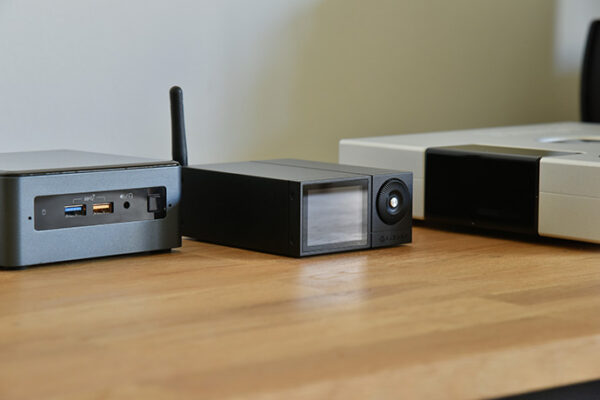

Nate
Hi Yagiz,
Good review!
I need your input:
Is this E70V would be a good DAC match with Topping A90D for HD800?
or do you think HD800 would be sound good just with RME ADI-2 FS DAC?
Thanks
Yagiz
Totally yes. The E70V & HD800 combo would perform great. I don’t believe you need the RME, I find them a tad overpriced.
Daorom
Hi YAGIZ.
you compared e70v with Yulong Dart Aurora? Which one is more musical, melodic, natural…? I have e70v+l70 + Edition XS. After about 36 hours, the sound improved noticeably and became very pleasant and clear. Fully agree with your review!
Yagiz
Hello Daorom,
Stick with the E70V / L70 combo. Technical capability is superior compared to the Aurora. The Aurora lacks the refinement and resolution. I’d recommend getting a copper wire upgrade for the Edition XS.
If you can DIY, I recommend this wire.
All the best,
Y
Nelu
Hi
I have a pair of Dynaudio Emit 10 connected to an H80 Hegel amplifier.
Amplifier which has an integrated DAC.
Now I’m a little bit confused, because I don’t know which DAC would be better, with a better sound: Hegel’s integrated DAC or this one?
Yagiz
Definitely the E70V as it is a dedicated DAC with impressive performance.
Hook it up to the H80 and enjoy the Emit 10s 🙂
Peter
I would be more cautious with such declarations
Nelu
Thx for this fast answer, I’ll give him a try
All the best for you
Robert
Hi,
Hi,
Which warmer sound dac for Bluesound node n130? Topping e50 or e70?
With my system and music, older Rock and metal, i don’t like bright sounding streamer. Have looked at the Cambridge cxn v2 but too bright with my music.
Tannoy xt8f, mf m5si, Bluesound node.